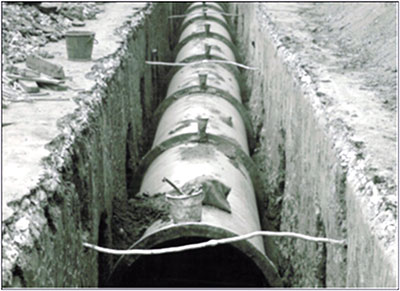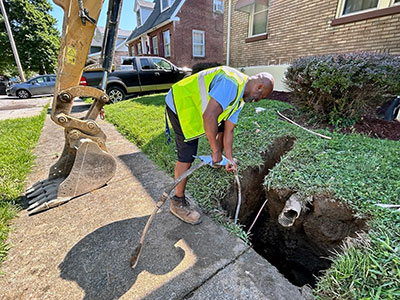Louisville Water Meets New Regulations for Lead and is Helping Customers Replace Lead Service Lines for Free
 Louisville Water meets the requirements of an updated regulation that’s focused on eliminating the risk of lead getting into drinking water. Louisville’s drinking water is high-quality and reliable and does not contain lead when the water leaves the treatment plants. The risk for lead to get into the water comes from pipes and plumbing made of lead. Louisville Water scientists balance the water chemistry to minimize this risk, but replacing lead service lines is the best way to eliminate the risk.
Louisville Water meets the requirements of an updated regulation that’s focused on eliminating the risk of lead getting into drinking water. Louisville’s drinking water is high-quality and reliable and does not contain lead when the water leaves the treatment plants. The risk for lead to get into the water comes from pipes and plumbing made of lead. Louisville Water scientists balance the water chemistry to minimize this risk, but replacing lead service lines is the best way to eliminate the risk.
The Environmental Protection Agency (EPA) regulates the nation’s drinking water providers and has revised an existing rule on Lead and Copper. The EPA mandated that utilities create an inventory of the utility-owned water service lines that connect to a customer’s property including an inventory for the lines on a customer’s property. The EPA set a deadline of October 16, 2024 for water utilities to publish the inventory. The utility must explain whether the lines are made of lead, galvanized steel, copper, or explain if the material is unknown.
Louisville Water meets the regulation, has published its inventory, and is helping customers remove lead and galvanized steel service lines on their property for free.
Detective Work to Get the Inventory
Louisville Water spent more than a year working on its inventory, combing through records and handwritten field notes that date back to the 1800s, looking at publicly available construction information for private property and using predictive modeling to finalize an inventory for the material of more than 300,000 service lines.
 Decades ago, lead was a common material used by utilities and plumbers to provide water service. But as science evolved and the risks for lead exposure were understood, different material was used. Louisville Water has replaced the known lead service lines – some 74,000 – that we installed decades ago. Now, we’re focused on helping customers identify and replace lead service lines on their property. We’ve created a lookup tool on LouisvilleWater.com where customers can check our records using their Louisville Water account number. Customers can also contact us if they do not have access to a computer.
Decades ago, lead was a common material used by utilities and plumbers to provide water service. But as science evolved and the risks for lead exposure were understood, different material was used. Louisville Water has replaced the known lead service lines – some 74,000 – that we installed decades ago. Now, we’re focused on helping customers identify and replace lead service lines on their property. We’ve created a lookup tool on LouisvilleWater.com where customers can check our records using their Louisville Water account number. Customers can also contact us if they do not have access to a computer.
An important date: 1950. Our research shows that we have not seen a private lead service line on a property where the home or business was built in 1950 or later. That’s the result of our detective work. To confirm this information, Louisville Water conducted a statistical analysis of post-1950 service line material, both public and private. That analysis concluded with greater than 95% confidence that there are no lead services lines in our system after 1950.
More about Louisville Water’s Inventory
The online database shows the service line material for Louisville Water installed lines and the private lines on the customer’s property. If a customer sees “unknown” for their service line, there are instructions on how to identify the material. If the service line material is listed as “lead” or “galvanized”, Louisville Water will replace the customer’s line for free.
 Of our 300,000 service lines, there are 48,000 addresses where we do not have information – those are classified as “unknown.” Based on our research, we estimate that up to 5,000 of those “unknowns” could be made of lead – and we want to replace those for free.
Of our 300,000 service lines, there are 48,000 addresses where we do not have information – those are classified as “unknown.” Based on our research, we estimate that up to 5,000 of those “unknowns” could be made of lead – and we want to replace those for free.
The database includes information for 2,500 addresses that have a known lead or galvanized line.
Where are most of the unknowns and known lead and galvanized lines located? Predominantly in the older neighborhoods of Louisville. That’s why the 1950 date matters – our research shows we have not seen a lead service line on a private property that was built after 1950.
Louisville Water started operations in 1860 and as the city grew, so did Louisville Water’s service area. Most of the remaining lead service lines on a customer’s private property were installed before 1950. Our continual work to balance the water chemistry minimizes the risk for lead to get into the water but replacing the lead line is important. That’s part of the EPA’s new regulation; EPA has set a goal of replacing all lead service lines (those installed by the utility and the customer) in the next 10 years.
Louisville Water has already communicated with customers with an unknown service line material or a known lead or galvanized service line. We’ll continue our outreach to identify the unknown material and help those with a lead service line that needs replacing.
Bottom line: Louisville’s drinking water is safe and high-quality, and working with our customers, we’ll finish replacing private lead service lines as we identify them.

